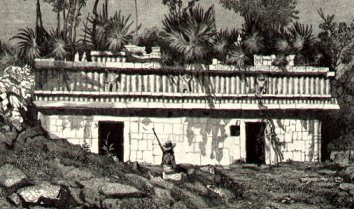Puuc
Puuc is a style of Pre-Columbian architecture of the Maya civilization. The name comes from the Maya language term for the range of hills in the south-east of the state of Yucatán and northern Campeche, Mexico.
The "Puuc" style is characterized by buildings of carefully cut stones. The lower portion of the fascades is blank with a flat surface of rectangular blocks punctuated by doorways, while the upper fascade is richly decorated with intricate stone mosaics, often alternating repeated geometric elements with more elaborate figurative sculpture.
Long nosed masks of the rain god Chac are found on many Puuc buildings.

Puuc building at Chunhuhub, Campeche
as drawn by Frederick Catherwood, 1841
The most famous "Puuc" architecture is at Uxmal; other major Puuc style sites in the region include Labna, Kabaah, and Sayil. The style is also seen at Bolonchen, Chunhuhub, Xculoc, and many smaller ruins. To the south-east the style can be found in Edzna; and to the west Chichen Itza has a few buildings in the Puuc style.

